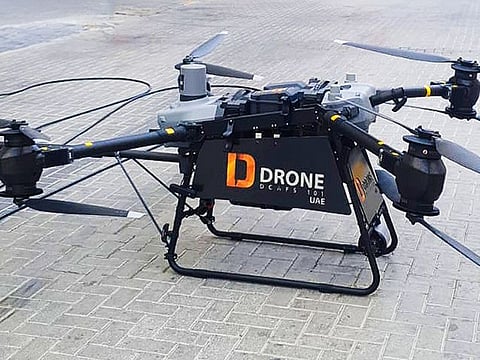Sharjah Civil Defence to use drones to combat fires in high-rise towers
Two drones will be put into service in the first quarter of next year

Sharjah: The Sharjah Civil Defence Authority is planning to use drone technology to deal with high-rise building fires in the emirate, starting next year. The authority explained that the new technology, which will be operational in the first quarter of 2025, will significantly contribute to achieving their strategic and operational goals, particularly in reducing fire response times and transitioning from traditional firefighting methods to advanced, innovative approaches.
The Sharjah Civil Defence Authority conducted a practical test of this technology last Wednesday, in the presence of the technical team from Civil Defence and the UAE-based company, Drone First Building Service. The test aimed to ensure the efficient use of the new technology and to implement necessary improvements for achieving the highest levels of performance, efficiency and effectiveness in firefighting.
Successful test
Brigadier Sami Al Nuqbi, Director General of the Civil Defence Authority in Sharjah, said: “We tested the drone, and it successfully passed, reaching an altitude of 150 metres, equivalent to about 40 floors, in just 18 seconds.” He added that the drone demonstrated the ability to spray water at this height, reaching up to 15 metres, from an internal tank with a capacity of 5,000 litres, which is refilled via a water hose connected to a ground tank.
Brigadier Al Naqbi explained that the drone can be equipped with a thermal camera, which helps firefighting teams identify the source and intensity of heat, as well as areas of concentration, especially in large spaces. This will enable firefighting teams to make important decisions quickly to control the incident.
Reducing response time
Brigadier Al Naqbi pointed out that due to the size of large fire trucks and the nature of some narrow buildings, firefighting teams may face obstacles in traffic, which can cause delays in response time. Meanwhile, a drone can be transported in a small vehicle and launched directly at the site, ensuring a much faster response.
Continuous improvements
Brigadier Al Naqbi pointed out that two drones will be put into service in the first quarter of next year, explaining that the drone devices are largely ready for operation. Still, they are subjecting them to performance improvements regarding some details such as the diameter of the water spray hose, the water pumping power, and the use of other firefighting materials like foam or dry powder. Additionally, they are considering adding an audio evacuation instruction feature and increasing the maximum altitude of the drone from 150 to 200 meters, which is equivalent to about 60 floors, to make it more efficient in high-rise building fires.
He explained that the drone, which weighs 27 kilograms, can be powered by a battery or electricity, and can operate for up to 12 continuous hours. He pointed out that it is equipped with night lights, temperature sensors, and a parachute system for emergency landings in case of malfunction, which prevents the drone from crashing to the ground.
Effectiveness in performance
Brigadier Al Naqbi said the efficiency of the drone in reaching greater heights far exceeds the current limit of 60 meters for the fire-fighting ladder belonging to the authority, which costs approximately Dh5.5 million. He said, "This confirms that investing in drones is not only a more efficient method for combating fires, but it is also cost-effective," pointing out that past events have highlighted the value and importance of drones in addressing fire incidents.
In comparison to a previous incident, Brigadier Al Naqbi provided an example of the significant difference that drone technology makes. He said, "For example, if drones had been used during a fire that broke out in one of the towers in Sharjah four years ago, we could have contained the fire within one hour instead of approximately six hours. This technology would have allowed us to better and more quickly protect lives and reduce property damage."
Brigadier Al Naqbi said: "We need to move beyond traditional methods and adopt current developments that provide us with high-precision data, conduct further experiments, learn about best practices, and harness all technologies for firefighting and combating, as well as enhance innovations."
A creative idea and vision
Mohamed Ghaith Jiratli, CEO of Drone Building Services, which supplies drones for firefighting and works on enhancing their performance, stated that the Sharjah Civil Defence Authority's vision to use drones in firefighting is both creative and forward-looking. He noted that the authority has adopted this approach as the first specialised entity and that it has been practically tested on the ground.
He added: "Since our partnership with them two months ago, we have customized the drones based on their feedback to meet the unique needs of high-rise building fires in the emirate," explaining that the integration of drones will undoubtedly set a new standard in firefighting efficiency. He further mentioned that their team is focused on enhancing the capabilities of the drones to ensure that they not only meet the expectations of the Civil Defence in Sharjah but also exceed them.
Sign up for the Daily Briefing
Get the latest news and updates straight to your inbox

_resources1_16a30b2e660_large.jpg?w=320&auto=format%2Ccompress&fit=max)
